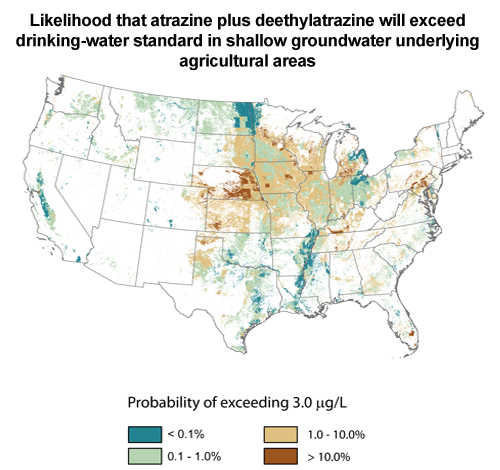
 |
Atrazine is one of the most extensively used herbicides in the United States, with average annual use over 70 million pounds – primarily for corn and sorghum. The U.S. Environmental Protection Agency (USEPA) established a Maximum Contaminant Level (MCL) of 3.0 µg/L for atrazine in public drinking-water supplies. MCLs are not regulatory standards for domestic supplies, but serve as benchmarks for potential human-health concerns. USEPA determined that atrazine and deethylatrazine (DEA), a breakdown product of atrazine, have additive toxicity and they have been considered together in this assessment for evaluating potential health concerns.
This map shows the predicted probability that atrazine plus DEA will exceed 3.0 µg/L in shallow groundwater underlying agricultural lands. About 95% of the nation’s agricultural areas have less than a 10% chance of exceeding this threshold. Although shallow groundwater in agricultural areas is seldom tapped by public-supply wells, these predictions are conservatively high estimates of the probability that atrazine plus DEA will exceed the MCL in deeper groundwater that may be used for drinking-water supplies. The highest probabilities are predicted for shallow groundwater in agricultural areas where substantial atrazine use is combined with natural conditions of permeable soils and high groundwater recharge, such as parts of eastern Nebraska. Probabilities of high concentrations are lower across much of the Corn Belt, where atrazine use is greatest, but soils tend to be poorly drained and often require artificial drainage that diverts recharge from groundwater to nearby streams. These findings are based on statistical models developed from almost 20 years of nation-wide monitoring data collected by the U.S. Geological Survey’s National Water Quality Assessment Program. Model predictions can be used to identify areas where atrazine may or may not be of concern and set priorities for future monitoring.
For further details, see Stackelberg, P.E., Barbash, J.E., Gilliom, R.J., Stone, W.W., and Wolock, D.M., 2012, Regression models for estimating concentrations of atrazine plus deethylatrazine in shallow groundwater in agricultural areas of the United States. Journal of Environmental Quality 41(2). Available online at https://www.crops.org/publications/jeq/view/41-2/q11-0200.pdf
Posted on February 27, 2012